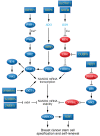Hypoxia-inducible factors: cancer progression and clinical translation
- PMID: 35642641
- PMCID: PMC9151701
- DOI: 10.1172/JCI159839
Hypoxia-inducible factors: cancer progression and clinical translation
Abstract
Hypoxia-inducible factors (HIFs) are master regulators of oxygen homeostasis that match O2 supply and demand for each of the 50 trillion cells in the adult human body. Cancer cells co-opt this homeostatic system to drive cancer progression. HIFs activate the transcription of thousands of genes that mediate angiogenesis, cancer stem cell specification, cell motility, epithelial-mesenchymal transition, extracellular matrix remodeling, glucose and lipid metabolism, immune evasion, invasion, and metastasis. In this Review, the mechanisms and consequences of HIF activation in cancer cells are presented. The current status and future prospects of small-molecule HIF inhibitors for use as cancer therapeutics are discussed.
Conflict of interest statement
Figures



References
-
- Braun RD, et al. Comparison of tumor and normal tissue oxygen tension measurements using OxyLite or microelectrodes in rodents. Am J Physiol Heart Circ Physiol. 2001;280(6):2533–2544. - PubMed
-
- Vaupel P, et al. Oxygenation status of malignant tumors vs. normal tissues: critical evaluation and updated data source based on direct measurements with pO2 microsensors. Appl Magn Reson. 2021;52:1451–1479. doi: 10.1007/s00723-021-01383-6. - DOI
Publication types
MeSH terms
LinkOut - more resources
Full Text Sources
Other Literature Sources
Medical

